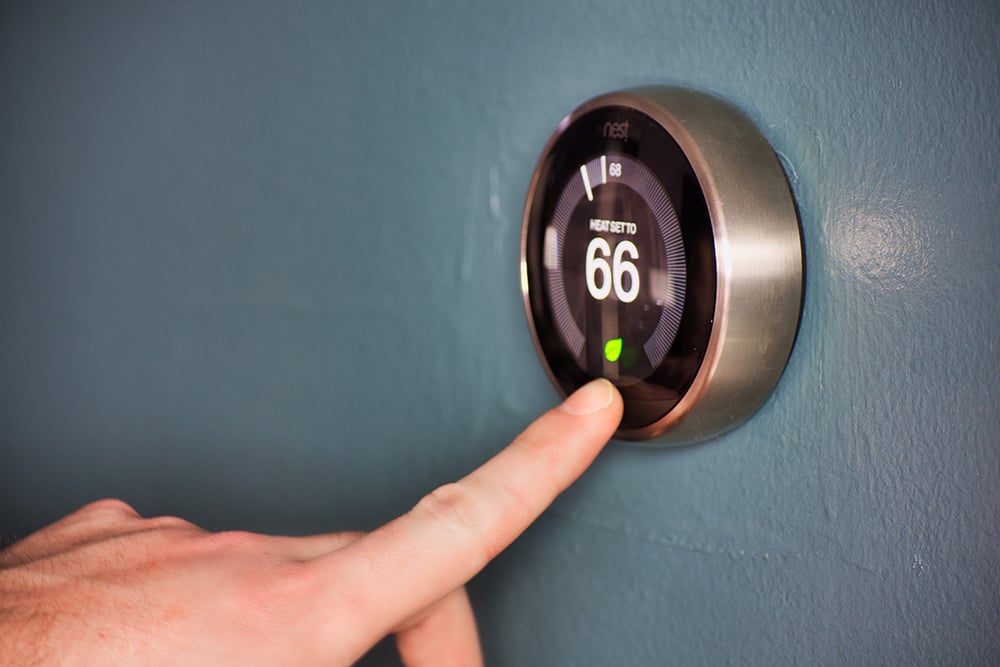Smart thermostats are just like traditional thermostats, except they can connect to WiFi. This allows you to control the temperature from your smartphone, set up smart schedules, and more. But will these features actually lower your energy bills? Here’s everything you need to know about how smart thermostats save you money and if it is really worth the cost.
Read More: How to save money and energy with smart home
How Do Smart Thermostats Save You Money?
Smart thermostats save money by automatically changing the temperature or turning your HVAC system off when you’re away from home or sleeping. You can set a smart thermostat to automatically turn off based on a schedule, using your location, with occupancy sensors, and more.
Here are all the ways a smart thermostat can help you save money on your energy bills:
- Physical Controls: You can change the temperature on a smart thermostat using the physical dials and buttons on the device itself. However, overriding your schedules and other features can negate some of the benefits of a smart thermostat and cost you more money in the end.
- Remote Control: You can control a smart thermostat from anywhere in the world using your smartphone (as long as you can connect to the internet). Additionally, you can link a smart thermostat to your smart home assistant and change the temperature using voice commands.
- Smart Scheduling: One of the most important things you need to do after installing a smart thermostat is to set up a schedule. With a smart schedule, you won’t ever forget to turn off your thermostat before you leave for work or accidentally fall asleep on the couch again.
- Geofencing: With this feature, a smart thermostat can track the location of your smartphone. This way, your smart thermostat will automatically turn off whenever you leave the house, even if it’s not on your smart schedule.
- Room Sensors: Some smart thermostats come with sensors, which can be placed around the home to keep certain rooms at a comfortable temperature. Room sensors with occupancy detection are also worth it because they will automatically turn off your smart thermostat when no one is home.
- Time of Use: With this feature, your smart thermostat will automatically turn off when energy demand is high. By running your thermostat when energy costs are cheaper, you can save a lot on your energy bills. However, you’ll need to apply for a program through your local utility company.
- Energy Monitoring: With the free companion app, most smart thermostats let you monitor your energy use, which can help you optimize your heating and cooling schedules. Many of these apps will also provide recommendations on how to save even more money with your particular setup.
- Alerts: Some smart thermostats will send notifications to your smartphone when there is a potential issue with your heating, ventilation, and air conditioning (HVAC) system.This way, you can quickly diagnose and fix any problems before they become more costly.
How Much Can Smart Thermostats Save?
According to Energy Star, smart thermostat will save you around 8% on your heating and cooling costs, which amounts to $50 a year on average. However, the agency says you could save up to $100 if your energy bills are high or your home is “unoccupied for much of the day.”
Some smart thermostat companies claim you can save even more. For example, Google says Nest thermostat will save you 10-12% on energy bills, while Ecobee claims you can save up to 26% by installing their smart thermostat, which would amount to a savings of $131-$284 a year.
That means it could take anywhere from 1-5 years for a high-end smart thermostat to pay for itself in most cases.
Read More: The best smart thermostats
When Smart Thermostats Won’t Save You Money
A smart thermostat will only save you money when connected to a central air conditioning system or a furnace. Also, you might not save very much if you live in a temperate climate, or someone is at home all the time. A smart thermostat won’t be worth it if you don’t use the features correctly.
If your home is heated with a boiler (and you have baseboard heaters or radiant flooring) a smart thermostat won’t save you much money. This is because steam and hot water heaters take a lot longer to change the temperature by a single degree, making smart thermostat adjustments less effective.
If you have a heat pump, a smart thermostat might not help either. Heat pumps are generally efficient, but they often use an auxiliary heat mode for significant temperature increases, which could consume a lot more power. However, there are some special smart thermostats designed to work with traditional staged heat pumps, but the efficiency will depend on your system.
Smart thermostats might not help you save money if you live in an area that doesn’t get too hot or too cold. While you will still save about 8% on your energy bills no matter where you live, it might not be worth it if it takes over 10 years for a smart thermostat to pay for itself.
Similarly, a smart thermostat won’t save you much money if someone is at home all day. The biggest benefits of a smart thermostat only come into play when your home is unoccupied for long periods of time, and your HVAC system turns off completely.
However, the main reason people don’t save money with a smart thermostat is because they don’t use it properly. In a 2022 study of 1,385 households, researchers found that real-world smart thermostat usage actually increased electricity and gas consumption by 2.3% and 4.2%, respectively. However, the study finds that this is mainly due to users frequently overriding their smart thermostats manually.
“We find that while some user types realize significant savings, engineering models fail to capture how the majority of people actually use smart technologies and this limits the usefulness of their estimates in real-world settings,” the researchers found. “More specifically, people adopt the smart technology but use its features in ways that undo the purported benefits, suggesting that human behavior is a peril to scaling such technologies.”
Can You Install a Smart Thermostat In Your Home?
Before you purchase a smart thermostat, you’ll need to make sure it is compatible with your HVAC system. To do this, pull the faceplate of your current thermostat. If you see thick, stranded wires, or it is only rated for 110-120 volts, you will not be able to upgrade to a smart thermostat.
Many smart thermostats also require a C-wire for power. If your current thermostat doesn’t have a C-wire, you might be able to use an adapter. However, you should make sure a smart thermostat will be compatible with your HVAC system’s wiring and power before you try to install it.
If you’re having trouble with your smart thermostat, HelloTech is here to help. We have thousands of professional technicians across the country who can come to your home and install any smart thermostat for you. After we leave, you’ll get 24/7 support for all your smart home devices.




